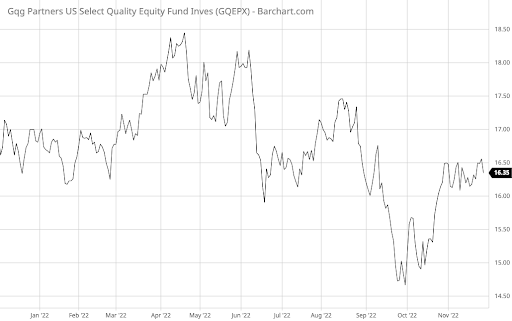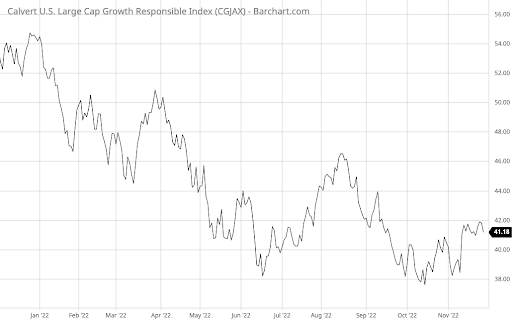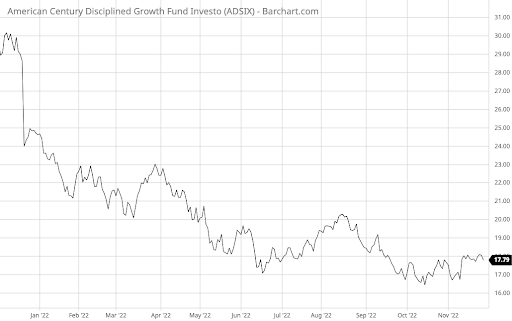First, we select the top trending category from more than 200 categories listed on MutualFunds.com based on the percentage increase in monthly viewership. Then, we choose the top three funds with the highest one-year trailing total returns from the top trending category. To ensure funds’ quality and staying power, we only look at those mutual funds with a minimum of $100 million in assets and a track record of at least three years. We also remove those mutual funds closed to new investors and unavailable for investment outside registered accounts such as retirement or 529.
In this edition, we look closely at trending Large-Cap Equity Funds. With the pullback in tech stocks and a looming recession, most large-cap equities are well off their 52-week highs. But, despite this poor performance, active large-cap managers experienced their best year against benchmarks since 2009, according to the latest SPIVA U.S. Scorecard. As a result, investors should take a closer look.
Be sure to check out the Large-Cap Equity Funds page to find out more about the other funds in this category as well.
Trending Funds
The GQG Partners U.S. Select Quality Equity Fund (GQEPX) took first place with a 3.36% decline over the past 12 months. With a 0.59% expense ratio and 0.82% yield, the fund is the highest-yielding option on this week’s list.
The fund seeks to invest in high-quality companies with attractively-priced future growth prospects in the United States. Using a fundamental investment process, the investment managers evaluate each business based on financial strength, earnings sustainability, and management quality while limiting downside risk over an entire market cycle.
The fund’s strong performance over the past 52 weeks is primarily due to its overweight exposure to energy companies (19.6% vs. 4.5% benchmark). For instance, the portfolio’s largest holding is Exxon Mobil Corp. (XOM) at 7.4%, which is up 78% over the past 52 weeks. That’s significantly better than the S&P 500 index’s 15% drop. In addition, the fund holds overweight positions in information technology, healthcare, and financials.
Want to know more about portfolio rebalancing? Click here.

Source: Barchart.com.
2. Calvert U.S. Large Cap Growth Responsible Index Fund (CGJAX)
The Calvert U.S. Large Cap Growth Responsible Index Fund (CGJAX) comes in second place with a 21.85% drop over the trailing 12-month period. With a 0.49% expense ratio and a 0.26% yield, the fund is the least expensive option on this week’s list.
The fund tracks the performance of the Calvert U.S. Large Cap Growth Responsible Index, which consists of large growth stocks selected from the 1,000 largest publicly-traded U.S. companies. The portfolio is built based on market capitalization and growth factors while adhering to The Calvert Principles for Responsible Investment.
Unlike the previous fund, the CGJAX portfolio has 84% lower fossil fuel reserves, 11% lower carbon emissions, and 22% lower toxic emissions than the Russell 1000 Growth Index due to its focus on responsible investing. The portfolio’s most significant holdings include Apple, Microsoft, and Alphabet, while it’s overweight in healthcare (17.76% vs. 12.17% benchmark) and utilities (1.26% vs. 0.05% benchmark).
Find funds suitable for your portfolio using our free Fund Screener.

Source: Barchart.com.
3. American Century Disciplined Growth Fund (ADSIX)
The American Century Disciplined Growth Fund (ADSIX) comes in third place with a 26.71% drop over the past 12 months. With a 0.99% expense ratio, the fund is the most expensive on the list.
The fund seeks long-term capital growth using a systemic process that emphasizes fundamental growth characteristics. In addition to seeking growth, fund managers use a multi-pronged framework to ensure investors receive compensation for their assumed risks.
The fund’s portfolio is concentrated in information technology (46%), consumer discretionary (16%), and healthcare (13%). Like the previous fund, the portfolio’s most significant holdings include Apple (13%), Microsoft (11%), and Alphabet (5%). However, three percent of the portfolio includes international stocks.
Learn more about different Portfolio Management concepts here.

Source: Barchart.com.
The Bottom Line
Want to generate high income without undertaking too much risk? Check out our complete Best High Dividend Model Portfolio.
All data as of November 23, 2022.

